| Start of section
Production, amateur Radio amateurs Aircraft model, rocket-model Useful, entertaining |
Stealth Master
Electronics Physics Technologies Inventions |
Secrets of the cosmos
Secrets of the Earth Secrets of the Ocean Tricks Map of section |
|
| Use of the site materials is allowed subject to the link (for websites - hyperlinks) | |||
Navigation: => |
Home / Patent catalog / Catalog section / Back / |
|
INVENTION
Patent of the Russian Federation RU2240443
![]()
VETROENERGETICAL INSTALLATION WITH VERTICAL AXIS OF ROTATION
The name of the inventor: Viktor Lyatcher
The name of the patent owner: Lytkher Viktor Mikhailovich
Address for correspondence: 125363, Moscow, ul. Shturvalnaya, 5, building 1, apt.129, VMLyatcher
Date of commencement of the patent: 2003.05.05
A wind power plant with a vertical axis of rotation refers to wind power, in particular to rotary wind power installations. The technical result is to increase the reliability and efficiency of the installation in harsh climatic conditions. The installation is a wind aggregate consisting of several (three or more) isosceles triangles, the lateral sides of each of which form an inclined blade, each horizontal section of which has a hollow aerodynamic profile oriented along the tangent to the circumference described by the center of this profile during the operation of the plant. The bases of the triangles are located horizontally at a small height from the ground and are connected together. The planes of the triangles are arranged so that the vertices of the triangles are interconnected by traverses forming a horizontal regular polygon. The pyramid, formed by inclined blades and horizontal traverses, is fixed in the lower part on a flat steel ring with an electrically conductive overlay that performs the functions of the rotor of a linear (arc) generator whose inductors, together with vertical discharge electromagnets and vertical supports, are resiliently fastened to several racks along the perimeter of the steel ring. Inductors are equipped with fans blowing, directing warm air towards the steel ring, on which, apart from the blades, a casing with movable louvers is fixed, receiving warm air from the fans and guiding it into the internal cavities of the blades. The vertices of the lower polygon according to the scheme of the spokes of the bicycle wheel are connected to the central bearing, mounted on a short support shaft, which receives the horizontal force.
DESCRIPTION OF THE INVENTION
The invention relates to wind power, namely to rotary orthogonal power units, and can be used to generate energy from air currents, in particular in harsh climatic conditions.
There are known helicoidal turbines with a vertical axis of rotation and blades curved along a helix (US Patent No. 5451137).
The disadvantage of this solution is the presence of a central shaft and a traverse connecting the blades to the shaft, which prevents a significant increase in the overall dimensions of the unit and its unit capacity, but also creates favorable conditions for the icing of parts of the installation and failures in work in areas with a harsh climate.
The closest to this invention is a self-supporting windmill with blades curved along intersecting helix lines forming a cylindrical truss made of bent elements supported by cantilevered traverses fixed to the axis of a slow-moving generator (USSR Authorship Certificate No. 1150395).
The disadvantage of this technical solution is the complexity of the design, which presents difficulties in manufacturing and installation, a large load on the support traverses and the shaft of the generator.
The technical result of the invention is an increase in reliability, especially in severe climatic conditions, and a certain simplification of the design.
The technical result is achieved by the fact that a wind power plant with a vertical axis of rotation, comprising blades fixed to the base, traverses, a generator, comprises an assembly of at least three flat elements in the form of isosceles triangles, the lateral sides of each of which form an inclined blade, and the plane itself Triangle is slightly deviated from the vertical outwards so that the vertices of the triangles are interconnected by traverses forming a horizontal regular polygon, each horizontal section of the windmill blade has a hollow aerodynamic profile oriented outward from the tangent to the circumference described by the center of this profile, the bases of the triangles are located horizontally at low altitude From the ground and connected to each other. In addition, in the wind power plant, the pyramid formed by inclined blades and horizontal traverses is fixed to the rotor of a linear (arc) generator in the form of a flat steel ring with an electrically conductive patch, the inductors of which, together with the vertical discharge solenoids and vertical supports, are resiliently fixed to Several racks along the perimeter of the steel ring.
In addition, in the wind power plant, the inductors are equipped with blowers with blowing direction towards the steel ring, on which the casing with movable blinds is additionally fixed.
The technical result is achieved by the fact that the vertices of the lower polygon are connected to the central bearing, which is mounted on the short support shaft.
Thanks to these improvements, the plant acquires increased resistance to strong winds and icing with a relatively simple design while maintaining high efficiency in operation.
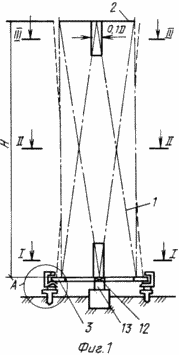 |
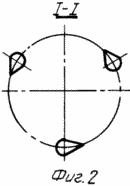 |
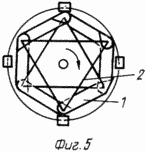 |
|
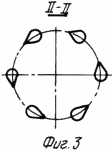 |
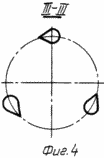 |
||
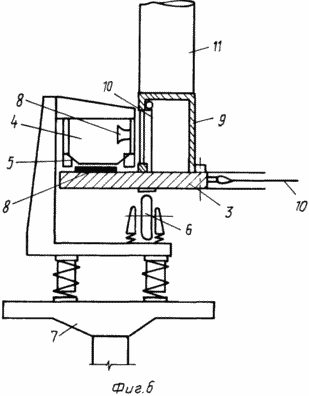 |
1 shows a wind power plant, a general view; FIG. 2 is a view II of FIG. 1; FIG. 3 is a view II-II of FIG. 1; FIG. 4 is a view III-III of FIG. 1; FIG. 5 is a wind power plant with louvers and traverses, 6 is a reference installation assembly. A wind power plant with a vertical axis of rotation consists of three or more vertical elements in the form of isosceles triangles 1, the lateral sides of each of which form an inclined blade, each horizontal section of which has a hollow aerodynamic profile oriented along the tangent to the circumference described by the center of this profile. The bases of triangles 1 are located horizontally at a small height from the ground and are connected to each other. The planes of triangles 1 are arranged so that their vertices are interconnected by traverses 2 forming a horizontal regular polygon (in FIG. 1-triangle). The pyramid formed by the oblique blades of triangles 1 and horizontal traverses is fixed to the rotor 3 of a linear (arc) generator in the form of a flat steel ring with an electrically conductive patch, the inductors 4 (Fig. 2) of which together with the electromagnets of vertical discharge 5 and vertical supports 6 Resiliently fastened to several racks 7 along the perimeter of the steel ring 3. The inductors 4 are provided with blowers 8 with a direction of blowing by warm air towards the steel ring 3, on which a light casing 9 with movable blinds 10 is further fixed, receiving warm air from the fans 8 and guiding it In the internal cavity of the blades 11 of the triangles 3. The end sections of the blades in the upper part are equipped with deflectors (not shown) creating an aerodynamic draft that promotes the movement of warm air along the inner channels of the blades 11 from the bottom up. |
||
The vertices of the lower polygon according to the scheme of the spokes of the bicycle wheel are connected to the central bearing 12 (FIG. 1), mounted on a short support shaft 13, receiving a horizontal force.
INSTALLATION WORKS AS FOLLOWING
At a low wind speed, the electromagnets 5 of the unloading of supports 6 are switched on, and the parking brake is deactivated. Under the influence of wind, the installation starts to rotate, and when the speed of rotation of a certain value is reached, the inductors 4 of the linear generator are connected to the electric network. The heat released in the inductors is directed by the fans 8 through the blinds 10 and the box 9 into the blades 11, freeing them from the hardened snow and ice. The improved aerodynamic quality of the blades 11 ensures further unscrewing of the blades and an increase in the power output from the inductors 4 into the electric network.
CLAIM
1. A wind power plant with a vertical axis of rotation, comprising hollow aerodynamic profile blades fixed to the base, traverses, generators, characterized in that it comprises an assembly of at least three flat elements in the form of isosceles triangles, each side of which forms an inclined The blade, each horizontal section of which has a hollow aerodynamic profile, oriented along the tangent to the circumference described by the center of this profile, the bases of the triangles are located horizontally at a small height from the ground and are interconnected, the planes of the triangles are arranged so that the vertices of the triangles are interconnected by traverses forming Horizontal regular polygon.
2. Wind power plant according to claim 1, characterized in that the pyramid formed by inclined blades and horizontal traverses is fixed to the rotor of a linear (arc) generator in the form of a flat steel ring with an electrically conductive patch, the inductors of which together with the electromagnets of vertical unloading and Vertical supports are resiliently fastened to several posts along the perimeter of the steel ring.
3. Wind power plant according to claim 1 or 2, characterized in that the inductors are equipped with blowers with blowing direction towards the steel ring, on which the casing with movable louvres is additionally fixed.
4. Wind power plant according to claim 1, or 2, or 3, characterized in that the vertices of the lower polygon are connected to a central bearing mounted on a short support shaft.
print version
Date of publication 02.02.2007gg




Comments
When commenting on, remember that the content and tone of your message can hurt the feelings of real people, show respect and tolerance to your interlocutors even if you do not share their opinion, your behavior in the conditions of freedom of expression and anonymity provided by the Internet, changes Not only virtual, but also the real world. All comments are hidden from the index, spam is controlled.